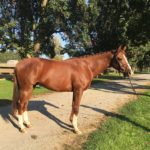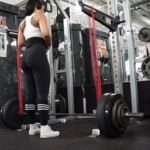No, you’re not on the wrong blog. And I didn’t get my avocations mixed up. This was just a happy coincidence, and too good not to share, especially since we’re still on the kinder, gentler fitness track. Behold the tennis ball. Your tight riding muscles? new best friend. Now,?I?ve played tennis most of my life and I thought the only good use for used tennis balls was making the day of an obsessed Golden Retriever (of which I have two). But wait. There’s more. At a Pilates class I attended a couple of weeks ago with Cassandra Thompson of ABSolute Pilates (now about to branch into a program just for equestrians called ABSolute Equestrian ? and Cassandra has promised some video samples!), we were talking about how muscle tightness in shoulders, lower back, hips and quads can hamper our riding. Apparently you have to get the knots out of your muscles before you can create those long, strong, flexible muscles we all want and need to be effective in the saddle while still moving fluidly with our horse. What’s more, if you try to strengthen knotty muscles they just get knottier ? and the knots get even more deeply ingrained. So out came a basket of old tennis balls. Apparently a used tennis ball is best because it has more give. There are, of course, more expensive ones you can buy just for this purpose. Or you can ask a tennis playing friend for a couple of castoffs. The technique is simple: just roll the ball around on your trouble spots (hips, IT band, calves, shoulders, lower back, etc.) until you find an ouchy spot (that’s a medical term . . . or it should be) and then roll it back and forth, all around over that spot with as much pressure as is tolerable (you can use a wall or the floor if you can’t get enough pressure just pushing the ball into the spot with your hands. You might want some privacy for this if you have to get on the floor. It looks pretty weird. But it works!) A trigger point therapist once told me that you want as much pressure as you can stand before you start tensing up to avoid the pain. It’s a fine line and you have to cross it s few times to get familiar with how to flirt with it. The steady rolling pressure from the tennis ball will get those spots to release in much the same way as a deep tissue or trigger point massage . . . except this kind is free! And even better than that, relief is immediate, and you can address any tightness (even a crick in your neck) right when you first notice it. Best of all for our purposes, loosening up tight muscles before you ride will make your cues, connection with your horse’s movement and comfort much better. With a little further investigation into this matter, I learned that many dancers consider a used tennis ball a necessity, and they often carry this low-tech therapy in their dance bag to deal immediately with tight, overworked muscles. Pilates instructors (who often work with dancers) often keep a basket of them on hand for clients when they first arrive for a Pilates session to coax a tight muscle into releasing so they?ll get more benefit from their session. I’m thinking riding instructors should insist on this before a lesson! One note of caution, however. This is not meant for injured, inflamed or acutely painful muscles. Those are probably best treated with an ice pack or a doctor visit; you are the only one who can judge the line between ouchy and injured. Working gently can be effective, however, in bringing blood flow to an irritated area to loosen up tight muscles and break up fascia. Here’s what to do: Body: Lying on the floor ? or up against a wall or in a chair if floor pressure is too much, position the ball near where the sensitive area is most acute. Work your way down your whole body, from head and neck to calves and ankles. Begin by slowly and gradually rolling around on the ball to find the exact spot. Increase or decrease the pressure to achieve the sensation of a deep tissue massage. And remember, if you feel yourself tightening your muscles to resist the pressure, ease off that spot, but continue rolling around it with less pressure. Once you find the trigger point and the right amount of pressure (work right up to the edge of discomfort), hold that spot and take three or more deep breaths; then ease off. Repeat on the same spot until the muscle releases and pain decreases or disappears. After working on one side of your body, rest for a minute or two to get a feel for how much that side has improved before repeating the process on the other side. Feet: For a lot of reasons that have more to do with reflexology, working the bottoms of your feet with a tennis ball is an amazing help for promoting circulation and flexibility in those hard-working extremities ? and this will help you keep your legs long and heels correctly positioned in the stirrups and for more effective cues. Starting at the ball of the foot, step on the ball and curl your toes downward as you roll back and forth and around the ball of your foot. Add as much pressure as is comfortable, working up to standing on the ball as you do this (Be sure to hold onto something though. You don’t want to have to tell people you got bucked off a tennis ball.). Now, moving to the arches, stand with feet shoulder-width apart and step on the ball, rolling it around until you find the ouchy spot, then put as much weight as you can onto it and take a few deep breaths. The heel can also be a sore point, and can be worked in much the same way. Be sure to work both heel, one at a time of course. Please note, however, that a sore heel can also be a symptom of a heel spur, a medical condition that requires a doctor?s care and can be aggravated by any pressure, especially tennis-ball trigger-point therapy. So if your heel is especially painful, stop immediately and get this checked out! ?Tennis Ball Trigger Point Massage? is most effective when followed up with gentle stretching of these muscles. (Stay tuned for some good stretches for riders to do before and after your ride.) It often has the added benefit of increasing range of motion and making your strength training more effective. But I?ve gone on far too long. Can you tell I’m excited about this? Have I been spending too much time with that aforementioned Golden Retriever? We?ll get to strength training next . . . and some interesting ways to sneak it into your barn routine without drawing too many stares OR going to the gym.?And if ?you don’t know anyone who plays tennis, email me (mkfolse@gmail.com) your address and I’ll send you a tennis ball. I happen to have more used tennis balls than even my dog can chase. I’ll be happy to share! Give this a try and let me know how it goes!










